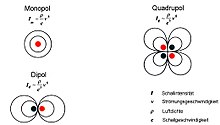Aeroacoustics
The aeroacoustics or flow acoustics deals with the emergence and spread of aerodynamically generated noise and its reduction. The importance of aeroacoustics in the aerospace and vehicle industries has increased significantly in recent years. In vehicle acoustics, this is due to the customers' growing awareness of comfort. The number of aeroacoustic wind tunnels has therefore increased steadily in the past. The experimental investigations are supplemented by numerical aeroacoustics .
Noise around the air flow is essentially caused by three different noise generation mechanisms:
- Volume flow through small openings;
- Alternating pressure application of solid surfaces;
- turbulent shear stresses.
Acoustic analogy
Idealized approximation models ( acoustic analogy ) can be used to characterize the individual mechanisms :
- Volume flows subject to alternating pressure can be represented by monopole radiators . Simply put, a monopole radiator represents a breathing sphere and accordingly radiates equally in all directions. Examples of this type of sound source are sirens, leaks in sealing systems or the exhaust mouth of a vehicle.
- The acoustic effect of alternating pressure on a solid surface can be represented by a dipole radiator . This type of noise emission is present whenever a free or detached flow hits a surface. This applies to motor vehicles, for example. B. for the caster behind the exterior mirror when it collides with the vehicle structure again.
- Turbulent shear stresses generate quadrupole radiators . Such emitters arise, for example, in turbulent shear layers or in the wake of a vehicle.
As mentioned above, the sound intensities of these three types of sources are quite different. For a monopole source one gets with the flow velocity , the density , the speed of sound and the Mach number
- ,
for a dipole source
and for a quadrupole source
- .
Significance of the mechanisms of sound generation
The comparison of the intensities shows that at low flow velocities (Mach numbers less than 1) the monopole source is most effective, followed by the dipole source. The lowest radiation is generated by quadrupole sources, which in most cases can be neglected in the aeroacoustics of road vehicles, buildings, etc. So, if there is a monopoly source, it will usually be the loudest source. Only when all monopole sources are eliminated can one of the remaining dipole sources dominate.
Properties of aeroacoustic sources
As can be seen from the above equations, the sound power of a monopole source is proportional to the 4th power of the flow velocity, while the sound power of a dipole source increases with the 6th power of the speed. Since the effective aerodynamic noise generation mechanisms of road vehicles and airplanes can generally be represented by a mixture of monopole and dipole radiators, an increase in sound power with the 4th to 6th power of the speed is often observed in experiments.
With aeroacoustic measurements, the speed must therefore be adhered to very precisely. Even small deviations in the setting can lead to significant level changes. This means that aeroacoustic measurements outside of aeroacoustic wind tunnels in unpredictable wind conditions are only meaningful with reservations, if the relative flow velocity and direction are not recorded.
In the case of motor vehicles, the distribution of the flow velocity over the entire vehicle surface is very uneven. Therefore, the potential noise excitation varies in size depending on the excitation location. Assuming dipole behavior, the sound generated at one location is 9 dB louder than at an adjacent one if the local pressure coefficients prevailing there are -1 or 0, respectively. With pressure coefficients of 0 and –2 (a value not unusual for the region around the A-pillar of a car ), this difference is even 14 dB. This shows that the positioning of attachments, e.g. B. exterior mirrors, can be of great importance for the aeroacoustic behavior of a vehicle.
The frequency of the emitted noise depends on the characteristic dimensions of the component in which the flow is flowing and the flow velocity. For the vehicle body and its attachments and details, the associated frequencies can be calculated using the equation
Estimate, representing a characteristic dimension (e.g. height or width) of the individual component or details and the Strouhal number . In general, the Strouhal number can be assumed to be approximately 1 for add-on parts. For cylindrical parts, however, it should be set at 0.2. The diameter is chosen here as the characteristic dimension. So z. B. for a radio antenna on a vehicle roof with a diameter of 5 mm at a flow velocity of 40 m / s a frequency of about 1600 Hz. Antennas can therefore attract attention with annoying whistling tones (see also Kármán vortex street ).
literature
- Marvin E. Goldstein: Aeroacoustics . McGraw-Hill International Book Company, New York 1976, ISBN 0-07-023685-2, ( online [accessed May 20, 2014]).
- Helfer, Martin: Aeroacoustics . In: Hucho, WH (Ed.): Aerodynamics of the automobile - fluid mechanics, heat engineering, driving dynamics, comfort . Wiesbaden: Vieweg, 2005. ISBN 3-528-33114-3
Web links
- Aeroacoustic wind tunnel ( Memento from January 11, 2013 in the Internet Archive )
- Frank Kameier, Dieter Reinartz: Fluid Acoustics University of Applied Sciences Düsseldorf University script from September 2001, accessed on June 15, 2016.
- Brandenburg Technical University: Department of Technical Acoustics













